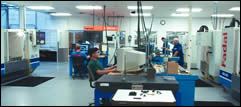Digital Control Has Increased Accuracy And Speed For Printing Product Provider
This shop ran beta tests of a new digital control for a machining center and noticed improved accuracy and reduced cycle time in both engineering and machining processes. Now the shop hopes to retrofit more of its machining centers with this control.
Solid modeling is improving processes from concept development and engineering through manufacturing, particularly 3D parts and molds. Because the slower CPU and communication speeds of some CNC controls are unable to accurately reproduce the improved geometry from solid models, manufacturing has been slower in recognizing the benefits of solid models. In a beta test of a new digital control developed by Fadal Machining Centers (Chatsworth, California), Printronix (Irvine, California), a provider of industrial printing solutions, noticed improved accuracy and reduced cycle time in both engineering and machining processes.
"In benchmark tests, the (Fadal) 104/D controller on the same model VMC allows us not only more speed, but also better quality," says Bruce Sobczak, production engineering manager at Printronix. "With the slower control, you can see flaws in the geometry, especially when we get into complex 3D programming. The geometry machined with the new control is crisp and has fewer flaws. In a lot of cases, the control eliminates secondary operations." The speed of the 104/D reduces machining cycle time while dramatically improving accuracy.
The manufacturing process at Printronix used to begin when the engineering department sent a solid model to a machinist. It was then translated into an IGES file, downloaded into a CAM system and outputed as a machining program. The new process eliminates the need for engineering to maintain two separate programs. This is made possible because the speed of the 104/D control allows accurate machining of draft angles and other features that have to be eliminated to machine a prototype part.
Eliminating two sets of geometry reduces engineering time and the opportunity for errors. Now, the solid model is sent to the machinist, who creates a tool path directly from the solid model using ProCNC. The program can be proved out using the graphics on the control, and the program is then ready to run.
Moving a job from engineering to manufacturing often requires downloading or uploading files and physically providing detailed drawings with tolerances and dimensions. Often, there are many questions to be resolved during the handoff, and the process can be time consuming. Solid models have eliminated much of that process by providing a complete part definition.
"Programs for machining parts or molds with complex 3D geometry can be 60,000 lines or more and take 30 to 45 minutes to upload," Mr. Sobczek explains. "With the new control, we can upload the same program in seconds. We then need to download the program and start cutting. Sometimes we'll machine as many as five different parts in a day. If we have to wait 30 minutes for each program, we've lost more than 25 percent of a shift."
Sometimes a prototype part or mold is machined to ensure that it will be functional before investing a lot of money in hard tooling. These prototypes are used in beta test units, and they therefore must function. "Form, fit and function are also very important to us," Mr. Sobczak says. "With a control such as the 104/D, we can produce a prototype out of the same material, so all the properties are the same as a molded part. The part has draft angles, and everything is as though it dropped out of the mold. Our goal is to make sure what we're taking in to test is not a toolroom version of something that will be different when we go to hard tooling. We typically machine to 0.0005-inch tolerances, and some parts require 0.0002 inch."
The ability to use graphics when proving programs has been improved with the controller as well. It provides accurate representations of the rapid moves, whereas the old control used approximations. "The old controller represented rapids as 45 degrees to the nearest axis, and then rapid traverses along the axis. When our machinists run tool verification with the new controller, there are no tool collisions because this controller runs the graphics exactly like it machines the part," Mr. Sobczak explains.
In the past, a fourth axis was used to reposition a workpiece automatically, eliminating the time spent manually repositioning with special fixtures. With the 3D contouring ability of the new controller and solid modeling, the company says it rarely has to go to a fourth axis to position parts. It's only when it gets into complex curves around part edges that it uses a fourth axis. "For 80 to 90 percent of our work, this controller can contour any radius, slope or draft angle without turning the part," Mr. Sobczak says.
"One of my machinists ran a little manifold, which is very complex, on the old control. It took 5 hours and 40 minutes, and on the new control, it ran in 50 minutes," he adds. "It's amazing how accurate they are. We are considering retrofitting more of our Fadals with the new control.
"The Printronix strategy is focused on quality. We have to get as much accuracy out of these machines as we can. The 104/D is helping us do that."
Read Next
3 Mistakes That Cause CNC Programs to Fail
Despite enhancements to manufacturing technology, there are still issues today that can cause programs to fail. These failures can cause lost time, scrapped parts, damaged machines and even injured operators.
Read MoreThe Cut Scene: The Finer Details of Large-Format Machining
Small details and features can have an outsized impact on large parts, such as Barbco’s collapsible utility drill head.
Read More










.png;maxWidth=300;quality=90)











